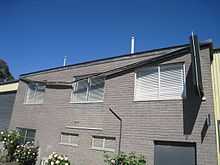Rain gutter

A rain gutter is a narrow channel, or trough, forming the component of a roof system which collects and diverts rainwater shed by the roof. It is also known as an eavestrough (especially in Canada), eaves channel[1] guttering or simply as a gutter.
Description
The main purpose of a rain gutter is to protect a building's foundation by channeling water away from its base. The gutter also helps to reduce erosion, prevents leaks in basements and crawlspaces,[2] protects painted or stained surfaces by reducing exposure to water,[3] and provides a means to collect rainwater for later use.
Rain gutters can be made from a variety of materials such as cast iron, lead, zinc, galvanised steel, painted steel, copper, painted aluminium, PVC (and other plastics), concrete, stone, and wood. More information on copper rain gutters is available.
Water collected by a rain gutter is fed, usually via a downspout or "downpipe" (traditionally called a leader or conductor[4]), from the roof edge to the base of the building where it is either discharged or collected.[5] Water from rain gutters may be collected in a rain barrel or a cistern.[citation needed]
Types

A rain gutter may be a:
- Roof integral trough along the lower edge of the roof slope which is fashioned from the roof covering and flashing materials.
- Discrete trough of metal, or other material that is suspended beyond the roof edge and below the projected slope of the roof.
- Wall integral structure beneath the roof edge, traditionally constructed of masonry, fashioned as the crowning element of a wall.[6]
A Box gutter is a deep gutter which is concealed within the structure of the roof.[5]

Cold forming technology exists to allow continuous gutters to be created, on site, in long individual lengths suitable to roof edge conditions, thereby reducing joints along the length of the gutter. These mostly joint free gutters are referred to as "seamless", and available in various shapes, sizes, and finishes.[8]
Rain gutters can be equipped with gutter screens, micro mesh screens,[9] louvers or solid hoods to allow water from the roof to flow through, while reducing passage of roof debris into the gutter.[10]
Precautions

Clogged gutters can cause water leakage into the house as the water backs up. Clogged gutters can also lead to stagnant water build up which allows mosquitoes to breed and also allows grasses and weeds to grow in the gutter.[11]
Gutters must be maintained regularly to remove leaves and other debris to keep them from clogging. [12] Gutters that are filled with debris can overflow and soak the foundation, damage the roof structure, and exacerbate ice dams in cold climates.
Effective gutter guards that keep debris out but allow water to enter are a good alternative to regular cleaning.[13]
Gutter protection devices include strainers, snap-in metal and plastic gutter guards, filtered gutter guards, stainless steel gutter guards, hinged gutter guards, plastic and metal total gutter covers, and even gutter brushes that look like hairy caterpillars.
Regardless of the gutter guard protection used, all gutter systems should be examined for cleaning and repair twice every year.[14]
Another option is to use a closed gutter to ensure that debris and leaves do not enter the gutter. The continuous hanger is a way to protect gutters from clogging and damage while reducing required cleaning to a minimum.
See also
- Chantlate
- Cornice
- Rain chain
- Box gutter
- Gargoyle
- Copper gutters and downspouts
References
- ↑ Sturgis, Russell (1901). A Dictionary of Architecture and Building: Biographical, Historical, and Descriptive.
- ↑ Truini, Joseph. "How to Install Rain Gutters". This Old House Magazine.
- ↑ Abrams, Gary (November 19, 2000). "How to Make Sure Your Rain Gutters Do Their Job Properly". Los Angeles Times.
- ↑ "Architectural Graphic Standards," First Edition, 1932, ISBN 0-471-51940-5, p. 77, 'Parts of a gutter' illustration
- ↑ 5.0 5.1 Ching, Francis D. K. (1995). A Visual Dictionary of Architecture. Van Nostrand Reinhold Company. p. 209. ISBN 0-442-02462-2.
- ↑ Sturgis' Illustrated Dictionary of Architecture and Building: An Unabridged Reprint of the 1901-2 Edition, Vol. II: F-N, p.340, ISBN 0-486-26026-7
- ↑ "Commercial Box Gutters Image".
- ↑ "Architectural Graphic Standards," Ninth Edition, 1994, p. 390, ISBN 0-471-53369-6.
- ↑ "Gutter Guard: What Is micro mesh filtration?". Retrieved 28 May 2013.
- ↑ "Gutter Guard: The Three Types". Retrieved 4 October 2012.
- ↑ "Mosquitoes and West Nile Virus in Delaware", dema.delaware.gov
- ↑ http://sechristwindowcleaning.com/2013/11/06/how-to-know-if-your-gutters-need-to-be-cleaned. Retrieved 06 January 2014. Missing or empty
|title=(help) - ↑ Seville, Carl (January 1, 2012). Green Building: Principles and Practices in Residential Construction.
- ↑ Ridout, Andrea (April 22, 2008). If I Had a Hammer: More Than 100 Easy Fixes and Weekend Projects.
External links
| Wikimedia Commons has media related to Rain gutters. |
- Youtube.com Benefits Of Gutter Screening
- "Gutter" in 1911 Britannica
- Ask the Builder on seamless vs traditional gutters
- An Illustrated glossary of roofs and roofing terms
- Alu-Rex on gutter protection and leaf guards.
